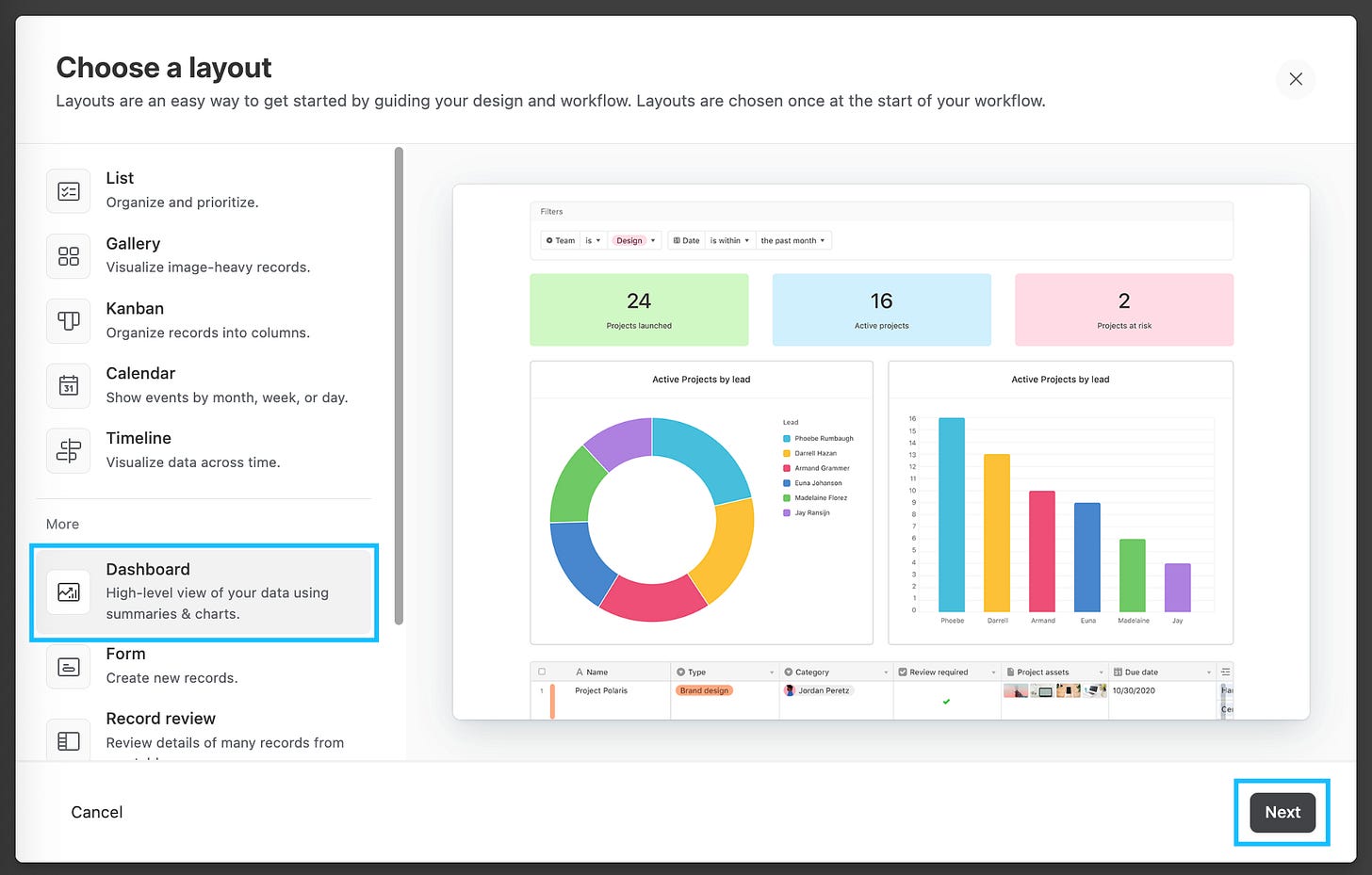Startup Story: Airtable
From Simple Spreadsheets to a Powerful Database: The Journey of Airtable
Welcome friends ☕️
Today, we’re talking about Airtable, the tool that took database creation and building apps to the next level. Let’s dive into how it began and what we can learn from its success.
The Inspiring Startup Journey of Airtable
What is Airtable and Who Started It?
Airtable is a tool that enables users to create applications and databases with a user interface that feels like a spreadsheet, allowing for more effective data organization and management. It is popular among teams for project management, collaboration, and custom workflow creation. Airtable’s platform supports various views such as Grid, Calendar, Kanban, Gallery, and Form, making it versatile for different types of data visualization and usage. Many companies, including Amazon, WeWork, and Netflix, use Airtable. Today, over 80% of Fortune 100 companies rely on Airtable for various purposes, including business roadmaps, sales management, and expense tracking.
Founded in 2012 by Andrew Ofstad, Howie Liu, and Emmett Nicholas, Airtable has its roots in the founders’ deep interest in technology and programming. Andrew and Emmett were classmates at Duke, while Howie, a year ahead of them, met Andrew through mutual friends. The three became lab partners in many classes and grew close as friends.
After college, Andrew took a job at Accenture, working in their R&D department building prototypes. Emmett went to Microsoft, and Howie stayed at Duke for another year. As Howie neared graduation, Andrew referred him for a position at Accenture. However, on Howie’s first day, he anxiously called Andrew, saying he was unable to work there. He said he was committed to starting a company. Howie asked Andrew to join him, but he declined, having just started his job.
Howie ended up founding a company called Etacts, a customer relationship management software platform, with another college friend. They applied to Y Combinator to launch the project, and Etacts was eventually acquired by Salesforce.
Andrew at this time was working as a product manager at Google and wanted to get back into creation and building things from scratch. The three eventually linked up again to get back to their roots of creating new products and started working on Airtable.
Kanban View in Airtable
How Did They Come Up with the Idea?
The idea for Airtable stemmed from the founders’ desire to create a tool that offered the ease of use of a spreadsheet combined with the power of a database. Liu saw that spreadsheets were being used as data storage solutions when there was a lot more potential for them. This vision was to allow non-technical users to build their own software solutions all from a spreadsheet-type user interface. Initially, Airtable was described to potential users as a “spreadsheet-database hybrid”.
Andrew Ofstad, inspired by tools like Sketch, was fascinated by the idea of making complex tasks accessible to everyone. He admired how Sketch made design easier and thought about applying the same principle to other products. This led to their focus of dumbing down the process of building software and making it accessible to non-technical users.
Simultaneously, Howie Liu’s experience at Salesforce revealed that most business applications were essentially reinventing the wheel—a database with some visual component on top and a business logic layer. Both Andrew and Howie wanted to make it simple for people to build useful business apps without needing deep technical knowledge.
Airtable Dashboard Builder
From Idea to MVP: The Development Timeline
Andrew and Howie began working on this idea together, initially creating prototypes to test their concepts. They spent a lot of time experimenting and discussing the future of computing. This period of exploration and prototyping helped them refine their vision and validate the feasibility of their idea.
The founders were inspired by the iterative development process of Bill Atkinson during the creation of the original Apple Mac. They adopted a similar approach, creating a feedback loop where they would design, implement, and test changes rapidly. Their initial prototypes were simple, focusing on answering the question: could they make databases simple enough for non-technical people to use? These early versions were essentially hacked together—frontend-only prototypes that didn’t save data, requiring manual reloading for each demo. This hacky approach allowed them to iterate quickly and gather valuable feedback.
Once Liu and Ofstad had an MVP, they needed funding. They visited Ashton Kutcher on the Warner Bros. lot in Los Angeles while Kutcher was filming episodes of his sitcom, Two and a Half Men. After being really impressed by the demo, Kutcher decided to invest in Airtable on the spot. With help from some additional investors, this gave them runaway to build their initial version of Airtable.
After about a year, they convinced Emmett, the best engineer they knew, to join them. Emmett’s expertise was crucial in turning their vision into a reality. The team separated the concept of launching the product from getting feedback. They engaged early alpha customers, including a friend using Airtable for video production and an early nonprofit user. By working closely with these initial users, they gained deep insights into what was challenging and how the product was being utilized. This focus on quality over quantity allowed them to refine Airtable based on real-world use cases.
Early Version of Airtable
Acquiring Customers
In the early days, Airtable’s user base was diverse, ranging from small businesses to large corporations. Initially, the founders thought their primary audience would be power spreadsheet users, such as financial analysts and consultants, who do a lot of modeling. However, they quickly realized that these users were already well-served by traditional spreadsheets, which excel at number crunching and financial modeling. Instead, they found that Airtable resonated more with systems thinkers and early adopter tinkerers—people who enjoy structuring information, tweaking tools, and optimizing processes.
The early adopters of Airtable were often the kind of individuals who liked messing around with new software tools. These users appreciated Airtable’s flexibility and structure. Over time, patterns began to emerge, revealing that the psychological profiles of tinkers, systems thinkers, and process-oriented people were a good fit for Airtable.
Airtable’s user base expanded across a wide range of industries and applications through word of mouth—from small businesses in automotive parts to large corporations. Notably, Netflix used Airtable for video production. This led to Airtable gaining traction within the original content community, becoming the go-to tool for those specific needs. Similarly, marketing teams started utilizing Airtable for content production, finding it particularly useful for planning and organizing their workflows.
The founders marketed to a wide range of people initially, attracting a diverse user base and then identifying pockets of similar use cases. They focused their marketing efforts and product development on these areas where they saw patterns of traction. By creating content tailored to specific industries and adjusting their roadmap to include features beneficial for these niches, they managed to increase engagement with these communities.
This approach of casting a wide net, identifying key user personas, and then doubling down on successful niches allowed Airtable to build a solid user base. The process took several years to play out, but it resulted in a product that was well-aligned with the needs of its users. This strategy helped Airtable gradually increase its visibility and adoption across various sectors, ultimately leading to its widespread use and success.
Competition
As Airtable gained traction, it entered a competitive landscape with several notable project management and collaboration tools. Here’s a brief comparison of Airtable with some of its key competitors:
Smartsheet offers a spreadsheet-like interface focused on advanced project management features, such as Gantt charts and resource management. While Airtable is more versatile and customizable, Smartsheet excels in detailed project tracking.
Asana is known for its task management and team collaboration capabilities, providing various project views like lists and boards. It focuses on task management simplicity, whereas Airtable offers more database functionality and customization.
Monday.com is a visually appealing, customizable work management tool with multiple views like Kanban and calendar. It is user-friendly but Airtable’s deeper database capabilities make it better for complex data management tasks.
Wrike is designed for large teams and enterprises, offering advanced features like time tracking and extensive reporting. It is highly scalable but has a steeper learning curve compared to Airtable’s user-friendly and flexible approach.
ClickUp is an all-in-one productivity platform combining task management, document collaboration, and goal tracking. Both offer high flexibility, but Airtable excels in data-centric workflows while ClickUp integrates multiple work aspects.
ReTool is a developer-focused platform for quickly building internal tools using pre-built components. It requires technical expertise, whereas Airtable is accessible to non-technical users, offering a simpler interface for custom applications and data management.
Conclusion
Each of these tools has its strengths and is suited to different types of users and needs. Airtable’s unique combination of spreadsheet simplicity and database power makes it a versatile choice for a wide range of applications. Its accessibility to non-technical users and flexibility in data management set it apart from competitors, particularly in scenarios where custom workflows and data organization are crucial.
Key Takeaways for Success
Airtable’s journey offers several valuable lessons for aspiring entrepreneurs:
✅ Simplicity + Powerful
Airtable succeeded by combining the simplicity of spreadsheets with the power of databases, making complex data management accessible to non-technical users.
✅ Iterative Development + User Feedback
Adopting a tight feedback loop allowed the founders to continuously test, refine, and improve their prototypes based on user feedback, ensuring the product met real user needs.
✅ Long-Term Vision
Building Airtable was a long journey. The founders’ commitment to a long-term vision and willingness to invest time and resources into perfecting the product were crucial to their success. Securing substantial seed funding ensured they had the runway to refine their product without immediate profitability pressures.
✅ Understanding and Engaging Early Adopters
By identifying the personas of early users, the founders tailored their marketing and development efforts to meet these users’ needs, leading to broader adoption.
✅ User Experience
Airtable’s emphasis on creating a high-quality, user-friendly product helped build a loyal user base. The commitment to refining the user experience ensured the product was functional and enjoyable to use.









